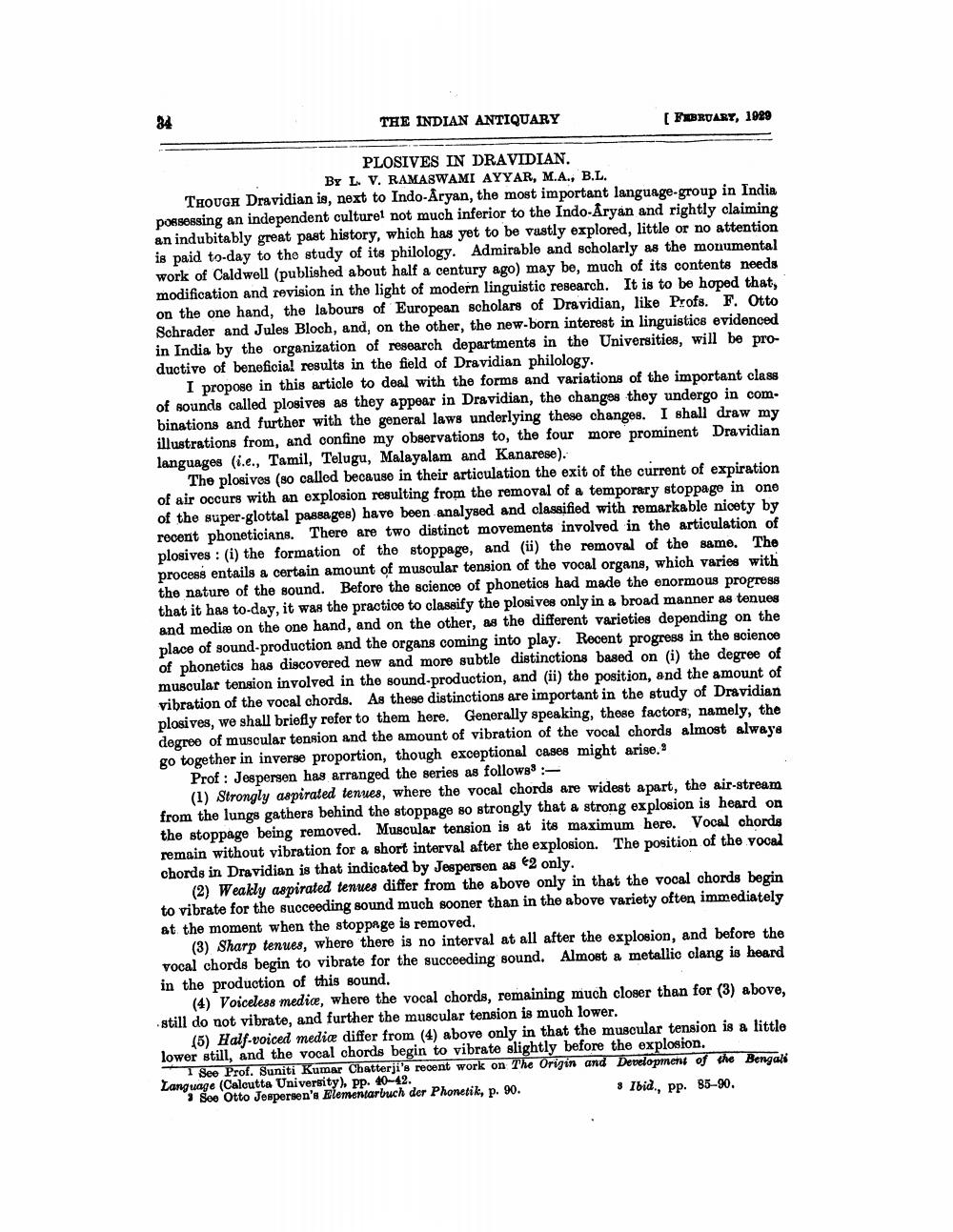________________
THE INDIAN ANTIQUARY
[ FEBRUARY, 1929
PLOSIVES IN DRAVIDIAN.
BY L V. RAMASWAMI AYYAR, M.A., B.L. THOUGH Dravidian is, next to Indo-Aryan, the most important language-group in India possessing an independent culturel not much inferior to the Indo-Aryan and rightly claiming an indubitably great past history, which has yet to be vastly explored, little or no attention is paid to-day to the study of its philology. Admirable and scholarly as the monumental work of Caldwell (published about half a century ago) may be, much of its contents needs modification and revision in the light of modern linguistic research. It is to be hoped that, on the one hand, the labours of European scholars of Dravidian, like Profs. F. Otto Schrader and Jules Bloch, and, on the other, the new-born interest in linguistics evidenced in India by the organization of research departments in the Universities, will be productive of beneficial results in the field of Dravidian philology.
I propose in this article to deal with the forms and variations of the important class of sounds called plosives as they appear in Dravidian, the changes they undergo in combinations and further with the general laws underlying these changes. I shall draw my illustrations from, and confine my observations to, the four more prominent Dravidian languages (i.e., Tamil, Telugu, Malayalam and Kanarese).
The plosives (80 called because in their articulation the exit of the current of expiration of air occurs with an explosion resulting from the removal of a temporary stoppage in one of the super-glottal passages) have been analysed and classified with remarkable nicety by recent phoneticians. There are two distinct movements involved in the articulation of plosives : (i) the formation of the stoppage, and (ii) the removal of the same. The process entails a certain amount of muscular tension of the vocal organs, which varies with the nature of the sound. Before the science of phonetics had made the enormous progress that it has to-day, it was the practice to classify the plosives only in a broad manner as tenues and media on the one hand, and on the other, as the different varieties depending on the place of sound-production and the organs coming into play. Recent progress in the science of phonetics has discovered new and more subtle distinctions based on (i) the degree of muscular tension involved in the sound-production, and (ii) the position, and the amount of vibration of the vocal chords. As these distinctions are important in the study of Dravidian plosives, we shall briefly refer to them here. Generally speaking, those factors, namely, the degree of muscular tension and the amount of vibration of the vocal chords almost always go together in inverse proportion, though exceptional cases might arise.
Prof: Jespersen hag arranged the series as follows:
(1) Strongly aspirated tenues, where the vocal chords are widest apart, the air-stream from the lungs gathers behind the stoppage so strongly that a strong explosion is heard on the stoppage being removed. Muscular tension is at its maximum here. Vocal chords remain without vibration for a short interval after the explosion. The position of the vocal chords in Dravidian is that indicated by Jespersen as 2 only.
(2) Weakly aspirated tenues differ from the above only in that the vocal chords begin to vibrate for the succeeding sound much sooner than in the above variety often immediately at the moment when the stoppage is removed.
(3) Sharp tenues, where there is no interval at all after the explosion, and before the vocal chords begin to vibrate for the succeeding sound. Almost a metallic clang is heard in the production of this sound.
(4) Voiceless media, where the vocal chords, remaining much closer than for (3) above, still do not vibrate, and further the muscular tension is much lower.
(5) Half-voiced mediæ differ from (4) above only in that the muscular tension is a little lower still, and the vocal chords begin to vibrate slightly before the explosion.
1 See Prof. Suniti Kumar Chatterji's recent work on The Origin and Development of the Bengal Language (Calcutta University), pp. 40-42. Soo Otto Jespersen's Elementarbuch der Phonetik, p. 90.
8 Ibid., pp. 85-90.




